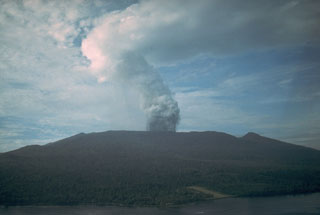Report on Karkar (Papua New Guinea) — November 1979
Scientific Event Alert Network Bulletin, vol. 4, no. 11 (November 1979)
Managing Editor: David Squires.
Karkar (Papua New Guinea) No strong explosions; crater morphology described
Please cite this report as:
Global Volcanism Program, 1979. Report on Karkar (Papua New Guinea) (Squires, D., ed.). Scientific Event Alert Network Bulletin, 4:11. Smithsonian Institution. https://doi.org/10.5479/si.GVP.SEAN197911-251030
Karkar
Papua New Guinea
4.647°S, 145.976°E; summit elev. 1839 m
All times are local (unless otherwise noted)
"As observed from the Kinim Observatory, no strong explosive activity occurred during November. During inspections of the summit and the crater lake floor on 17 and 18 November, it was found that fountaining of dark muddy water has virtually ceased and that several islands have been formed. The main island was [at the end of a peninsula] joined to the base of the S wall of the crater, and the other island was near the E edge of the lake. Several large boulders were present on the main island and it was bordered by narrow, smooth shores. Orange-brown discolouration was present over the central part of the island. At its N edge a vigorous geyser continuously jetted yellow-tinged water to heights of several tens of meters. The E half of the lake was green and the W half retained the same grey-brown colour seen previously."
Geological Summary. Karkar is a 19 x 25 km forest-covered island that is truncated by two nested summit calderas. The 5.5 km outer caldera was formed during one or more eruptions, the last of which occurred 9,000 years ago. The steep-walled 300-m-deep, 3.2 km diameter, inner caldera was formed sometime between 1,500 and 800 years ago. Cones are present on the N and S flanks of this basaltic-to-andesitic volcano; a linear array of small cones extends from the northern rim of the outer caldera nearly to the coast. Recorded eruptions date back to 1643 from Bagiai, a pyroclastic cone constructed within the inner caldera, the floor of which is covered by young, mostly unvegetated andesitic lava flows.
Information Contacts: C. McKee, RVO.

